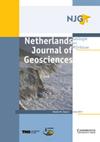Late-Holocene sea-level reconstruction (1200 BC–AD 100) in the Westergo terp region of the northern Netherlands
IF 2.3
2区 地球科学
Q3 GEOSCIENCES, MULTIDISCIPLINARY
Netherlands Journal of Geosciences-Geologie En Mijnbouw
Pub Date : 2021-02-17
DOI:10.1017/njg.2021.1
引用次数: 1
Abstract
Abstract In the early 20th century, archaeological research in the terp (artificial dwelling-mound) region of the northern Netherlands focused, besides settlement history, on natural salt-marsh dynamics and sea-level rise. In particular Van Giffen used salt-marsh deposits under dated terp layers to reconstruct the rate of sedimentation of the developing salt marsh and relative sea-level rise. This line of research in archaeology was rekindled during excavations in the terp of Wijnaldum-Tjitsma between 1991 and 1993. Since then, geology has become an integral part of archaeological research in the terp region. This paper focuses on the northwestern part of the province of Friesland (Westergo), where most archaeological terp research during the past three decades has been carried out, owing to several research programmes by the Province of Friesland. The primary aim of the geoarchaeological research is to better understand the interaction between human inhabitants and the salt-marsh landscape. The sedimentary record exposed in the excavation trenches makes it possible to collect data on the development of the coastal environments of the Wadden Sea prior to habitation, including data on sea-level rise. The sea-level data collected in the geoarchaeological studies in Westergo are the topic of this paper. The measured levels of the tidal-flat/salt-marsh boundary underneath the terps make it possible to reconstruct palaeo-Mean High Water (palaeo-MHW) levels. Such sea-level index points (SLIPs), based on marine shell data points from 12 locations, now make it possible to establish a palaeo-MHW diagram for this part of the Wadden Sea, for the period between 1200 BC and AD 100. In this period the palaeo-MHW in the Westergo region rose from c.1.8 m to 0.3 m −NAP: a mean sea-level rise of c.0.12 m per century. We discuss the fact that elevation of the palaeo-MHW SLIP is not only determined by relative sea level (RSL), but also by the magnitude of the tidal amplitude. The tidal range, and therefore the MHW elevations in a tidal basin, can change from place to place and also in time. Also in a single tidal basin the tidal range is variable, due to the distortion of the tidal wave as a result of the morphology of the tidal system. Such local tidal range fluctuations – not related to sea-level rise – influence the palaeo-MHW curve of Westergo and other tidal basins in the Wadden Sea and need to be taken into account when interpreting the curve. In this paper, we will go into the causes of changes in palaeotidal ranges in meso- and macrotidal systems, analyse the tidal range variations in recent and subrecent basins and estuaries and discuss the implications of these changes on the sea-level curve of the Westergo region in NW Friesland.荷兰北部Westergo terp地区晚全新世海平面重建(公元前1200年-公元100年)
20世纪初,荷兰北部terp(人工居住-丘)地区的考古研究除了关注聚落历史外,还关注天然盐沼动态和海平面上升。特别是,Van Giffen利用年代久远的台阶层下的盐沼沉积物,重建了盐沼发育的沉积速率和相对海平面的上升。1991年至1993年,在wijnaldom - tjitsma遗址的发掘中,考古学的这一研究方向重新燃起。从那时起,地质学就成为了特普地区考古研究的一个组成部分。本文的重点是弗里斯兰省的西北部(韦斯特戈),在过去的三十年中,由于弗里斯兰省的几个研究项目,大多数考古研究都在那里进行。地质考古研究的主要目的是更好地了解人类居民与盐沼景观之间的相互作用。挖掘沟中暴露的沉积记录使得收集瓦登海沿岸环境在人类居住之前发展的数据成为可能,包括海平面上升的数据。本文以韦斯特戈地区地质考古研究中收集到的海平面资料为研究对象。测量的潮滩/盐沼边界水位使重建古平均高水位(古mhw)成为可能。这种基于12个地点的海洋贝壳数据点的海平面指数点(SLIPs),现在可以为瓦登海的这一部分建立一个公元前1200年至公元100年的古mhw图。在此期间,Westergo地区的古海温从0.1.8 m上升到0.3 m - NAP,平均海平面每世纪上升0.12 m。我们讨论了古海相滑移带的高程不仅由相对海平面(RSL)决定,而且由潮汐幅值的大小决定。潮差,因此在潮汐盆地的MHW高程,可以随地点和时间而变化。在单个潮汐盆地中,由于潮汐系统的形态造成的潮汐波的扭曲,潮汐差是可变的。这种与海平面上升无关的局部潮差波动影响了韦斯特戈和瓦登海其他潮汐盆地的古海温曲线,在解释该曲线时需要考虑到这一点。本文将探讨中、大潮系统古潮差变化的原因,分析近代和次近代盆地和河口的潮差变化,并讨论这些变化对西北弗里斯兰韦斯特戈地区海平面曲线的影响。
本文章由计算机程序翻译,如有差异,请以英文原文为准。
求助全文
约1分钟内获得全文
求助全文
来源期刊
CiteScore
4.00
自引率
25.90%
发文量
14
审稿时长
>12 weeks
期刊介绍:
Netherlands Journal of Geosciences - Geologie en Mijnbouw is a fully open access journal which publishes papers on all aspects of geoscience, providing they are of international interest and quality. As the official publication of the ''Netherlands Journal of Geosciences'' Foundation the journal publishes new and significant research in geosciences with a regional focus on the Netherlands, the North Sea region and relevant adjacent areas. A wide range of topics within the geosciences are covered in the journal, including "geology, physical geography, geophyics, (geo-)archeology, paleontology, hydro(geo)logy, hydrocarbon exploration, modelling and visualisation."
The journal is a continuation of Geologie and Mijnbouw (published by the Royal Geological and Mining Society of the Netherlands, KNGMG) and Mededelingen Nederlands Instituut voor Toegepaste Geowetenschappen (published by TNO Geological Survey of the Netherlands). The journal is published in full colour.

 求助内容:
求助内容: 应助结果提醒方式:
应助结果提醒方式:


